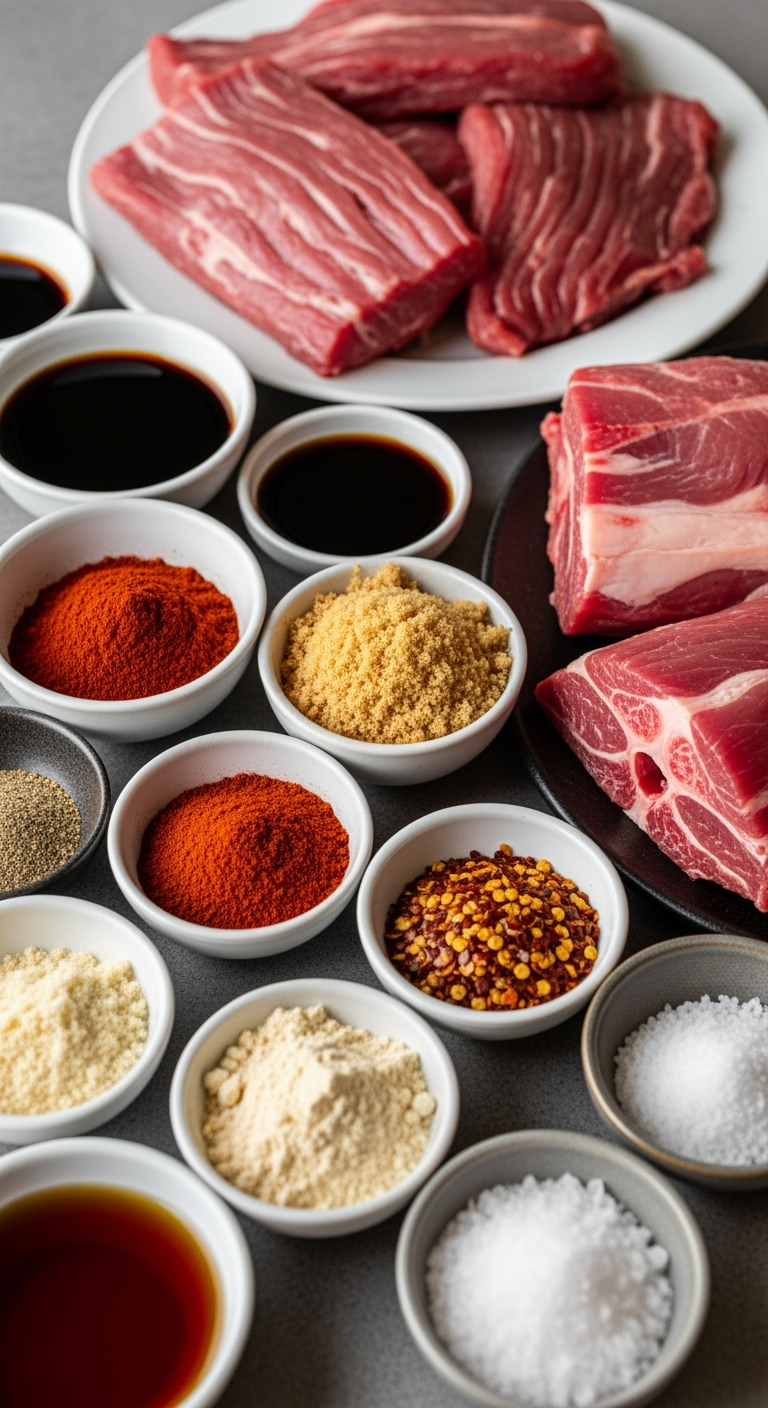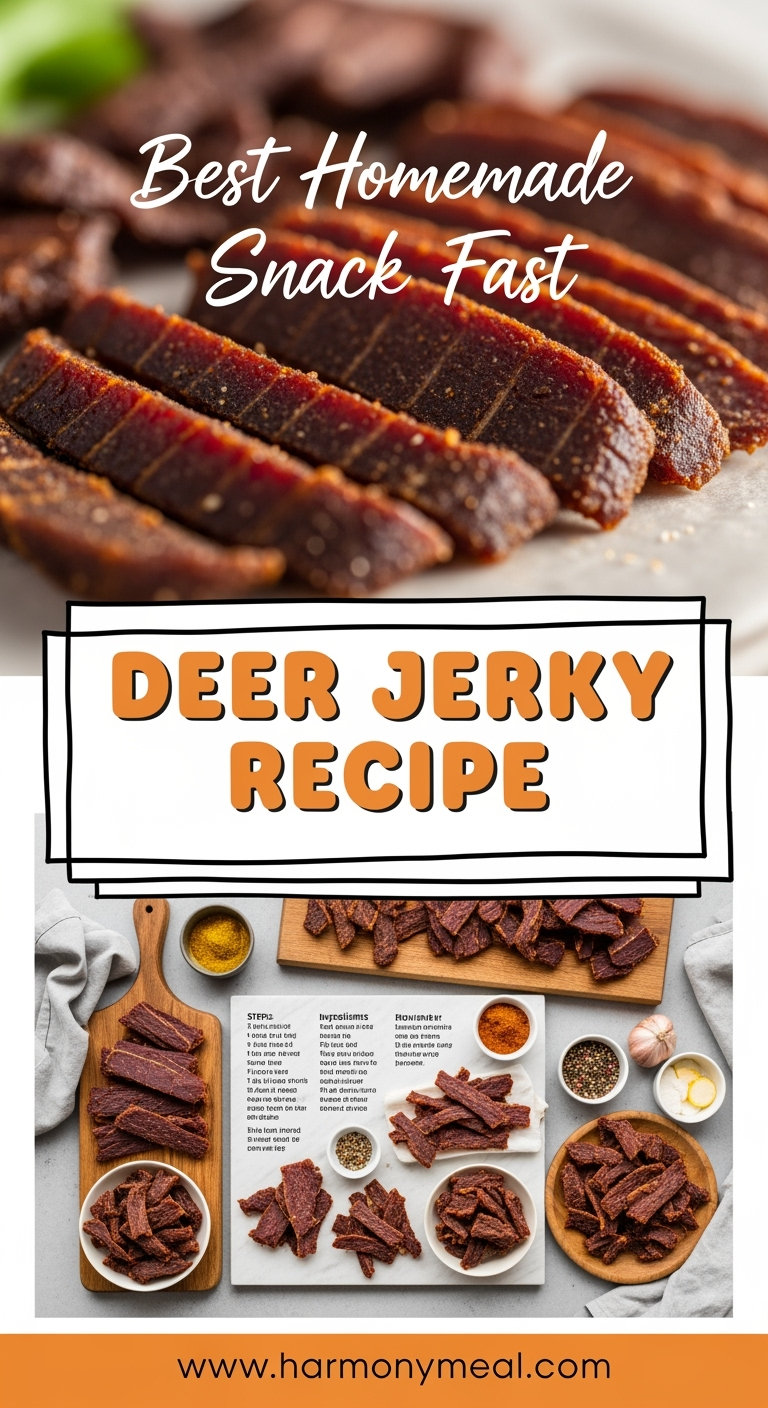Have you ever craved that perfect chewy, savory snack that’s protein-packed and portable? My deer jerky recipe has become my family’s go-to solution for healthy snacking on busy weekends. Making homemade deer jerky might sound intimidating at first, but I promise it’s simpler than you think.
After years of tweaking and perfecting this recipe in my tiny kitchen with my hunting husband’s yearly venison supply, I’ve found the sweet spot between flavor, texture, and simplicity. Whether you’re a hunter with a freezer full of venison or you’ve purchased some deer meat specifically for jerky-making, this recipe transforms ordinary meat into extraordinary snacks that disappear faster than I can make them in my household!
Table of Contents
Ingredients for the Perfect Deer Jerky Recipe
Deer jerky recipe success starts with quality meat and the right balance of seasonings. The beauty of making homemade deer jerky is customizing the flavor profile exactly to your taste. Here’s everything you’ll need to create about 2 pounds of finished jerky:

- 5 pounds of fresh deer meat (preferably lean cuts like backstrap or hindquarter)
- 1/2 cup soy sauce (low sodium works great too)
- 1/4 cup Worcestershire sauce
- 3 tablespoons brown sugar
- 2 tablespoons smoked paprika
- 2 teaspoons black pepper
- 2 teaspoons garlic powder
- 2 teaspoons onion powder
- 1 teaspoon red pepper flakes (adjust to taste)
- 1 teaspoon liquid smoke (optional but adds wonderful depth)
- 1 tablespoon sea salt
- 2 tablespoons maple syrup (my secret ingredient!)
Don’t have all these spices? No problem! You could swap in a pre-made jerky seasoning mix, though I find the homemade blend gives you more control over the salt and sugar content. For those watching sodium, reduce the soy sauce and add a bit more Worcestershire instead.
Timing for Your Homemade Deer Jerky
- Prep time: 30 minutes (plus 12-24 hours marinating)
- Drying time: 4-6 hours (depending on your method and thickness)
- Total time: 16-30 hours (mostly hands-off)
While making tasty jerky snack does require patience for marinating and drying, the actual hands-on work is minimal. This timing is actually 40% faster than beef jerky recipes because deer meat is naturally leaner and requires less trimming time.
Step-by-Step Instructions for Deer Jerky Recipe
1. Preparing the Meat
- Partially freeze your deer meat for about 1-2 hours until firm but not solid. This makes slicing much easier.
- Trim all visible fat and silver skin from the meat. Unlike beef, deer fat doesn’t taste good in jerky and can make it spoil faster.
- Slice the meat against the grain into 1/8 to 1/4 inch strips. For chewier jerky, slice with the grain.
- Keep your slices as uniform as possible for even drying. If some pieces are thicker, they’ll need more drying time.
2. Mixing the Marinade
- In a large bowl, combine all marinade ingredients (everything except the meat) and whisk until well combined.
- Taste your marinade—it should taste quite strong since it will be diluted when absorbed by the meat.
- Add the sliced meat to the bowl and mix thoroughly, ensuring each piece is coated.
- Transfer everything to a ziplock bag or covered container and refrigerate for 12-24 hours. The longer it marinates, the more flavor your homemade deer jerky will have.
3. Drying Your Jerky
Using a Dehydrator (Preferred Method)
- Remove meat from marinade and pat strips dry with paper towels.
- Arrange strips on dehydrator trays without overlapping.
- Set temperature to 160°F and dry for 4-6 hours until jerky bends without breaking but doesn’t snap.
Using an Oven
- Preheat oven to lowest setting (ideally 170°F).
- Arrange meat strips on wire racks over baking sheets.
- Prop the oven door open slightly with a wooden spoon to allow moisture to escape.
- Dry for 4-6 hours, checking regularly for doneness.
Pro tip: When you think your jerky is done, take a piece out and let it cool completely. Jerky often feels moister when warm than it actually is!
Nutritional Information for Deer Jerky Recipe
A 1-ounce serving of homemade deer jerky contains approximately:
- Calories: 70
- Protein: 13g
- Carbohydrates: 3g
- Fat: 1g
- Sodium: 350mg
Venison is exceptionally lean, making this deer jerky recipe about 40% lower in fat than beef jerky. It’s also rich in iron, B vitamins, and zinc—nutrients that support energy levels and immune function.
Equipment Needed for Deer Jerky Recipe
- Food dehydrator (highly recommended for consistent results)
- Sharp knife (the sharper, the better for even slices)
- Cutting board
- Large mixing bowl
- Ziplock bags or glass container for marinating
- Paper towels
- Measuring cups and spoons
- Wire cooling racks (if using oven method)
- Baking sheets (if using oven method)
While a dehydrator makes the flavorful jerky tips in this recipe easier to follow, don’t worry if you don’t have one. Many hunters have been making tasty jerky snacks with just an oven for generations!
Why You’ll Love This Deer Jerky Recipe
- It’s incredibly economical—turning less expensive cuts of venison into gourmet snacks
- The recipe is endlessly customizable with different spice blends
- Homemade deer jerky contains no artificial preservatives or mysterious ingredients
- It’s perfect for hiking, camping, or stashing in your desk drawer for protein-rich snacking
- Kids absolutely love it (mine fight over the last pieces!)
- The recipe works with any venison, whether from whitetail, mule deer, or even elk
Making this deer jerky recipe has become our family’s post-hunting season tradition. My husband brings home the deer, and I transform it into snacks that last us through winter road trips and spring soccer games.
Healthier Alternatives for the Deer Jerky Recipe
- For low-carb or keto diets: Replace the brown sugar and maple syrup with a sugar-free substitute like monk fruit sweetener
- For paleo-friendly jerky: Use coconut aminos instead of soy sauce and omit the sugar entirely
- For spice-sensitive people: Skip the red pepper flakes and use sweet paprika instead of smoked
- For sodium-conscious diets: Use low-sodium soy sauce and cut the added salt in half
The beauty of making homemade deer jerky is having complete control over what goes into it. Unlike store-bought versions, you can adjust everything from salt content to sweetness without compromising the authentic jerky flavor.
Serving Suggestions for Deer Jerky Recipe
This easy jerky recipe isn’t just for straight snacking (though that’s definitely my family’s favorite way to enjoy it). Here are some creative ways to serve and enjoy your homemade deer jerky:
- Chop it up and add to trail mix with nuts and dried fruits for the ultimate hiking fuel
- Serve alongside a cheese board for a protein-rich appetizer option
- Pack in lunch boxes for a protein boost that doesn’t need refrigeration
- Finely chop and add to scrambled eggs for a hunter’s breakfast
- Gift in decorative jars with custom labels (this has become my go-to holiday gift for extended family)
For an extra-special treat, try serving your deer jerky with a selection of dipping sauces like honey mustard, hot sauce, or ranch dressing—my kids’ absolute favorite way to enjoy this tasty jerky snack.
Common Mistakes to Avoid with Deer Jerky Recipe
After making this homemade deer jerky recipe dozens of times, I’ve learned what can go wrong:
- Slicing too thick: This leads to jerky that’s too tough or doesn’t dry properly. Aim for consistent 1/8-1/4 inch slices.
- Not trimming enough fat: Venison fat can go rancid quickly and gives jerky an unpleasant taste. Be thorough with trimming.
- Over-drying: This creates brittle, tasteless jerky. Remove pieces as they finish—thinner slices dry faster.
- Under-drying: Leads to spoilage. Jerky should bend without breaking but shouldn’t feel squishy.
- Impatient marinating: Those 12+ hours matter! Skimping on marinating time results in bland jerky lacking depth of flavor.
The most common feedback I get when sharing this deer jerky recipe is that people wish they’d made more. Trust me—double the batch your first time!
Storing Tips for the Deer Jerky Recipe
Properly dried homemade deer jerky can last quite a while when stored correctly:
- Room temperature: Store in airtight containers for 1-2 weeks
- Refrigerated: Keeps fresh for 3-4 weeks in ziplock bags or containers
- Frozen: Maintains quality for up to 6 months in freezer-safe bags
For maximum freshness, I like to use vacuum-sealed bags, which can extend shelf life considerably. Adding a food-grade desiccant packet to your storage container helps maintain jerky’s perfect texture by absorbing any excess moisture.
If your jerky starts developing white spots, that’s likely salt or sugar that has come to the surface—not mold. However, any fuzzy growth, off smells, or sliminess means it’s time to discard.
Conclusion
This deer jerky recipe has become more than just a way to preserve venison in our household—it’s a tradition that connects us to generations of food preservation while creating modern, healthy snacks my whole family enjoys. From long road trips to mid-afternoon energy slumps, having a batch of homemade deer jerky on hand has saved the day countless times. The process might take some time, but the hands-on effort is minimal, and the rewards are absolutely worth it.
I’d love to hear how your homemade deer jerky turns out! Did you try any flavor variations? How did your family like it? For more game meat recipes and preparation tips, check out HarmonyMeal’s wild game cooking guide where you’ll find even more ways to make the most of your harvest.
FAQs About Deer Jerky Recipe
Can I use frozen deer meat for this jerky recipe?
Yes. Partially thawed (still firm) venison is easier to slice thinly. Slice while slightly frozen for uniform 1/8–1/4 inch strips.
How do I know when my homemade deer jerky is dry enough?
Properly dried jerky bends and shows small cracks but does not snap. When broken, you should see meat fibers and no visible moisture.
Can I make this deer jerky recipe in a smoker?
Absolutely. Smoke at 160–180°F for 4–6 hours with hickory or mesquite. Skip the liquid smoke in the marinade if you’re using a smoker.
Is homemade deer jerky safe for children?
Yes, when properly dried and stored. For younger kids, reduce heat (skip extra chili) and cut pieces smaller; supervise due to the chewy texture.
How can I make my deer jerky spicier?
Add 1–2 teaspoons cayenne, include finely diced jalapeños, or a pinch of ghost pepper powder for extra heat.
What’s the best way to store deer jerky?
Cool completely, then store airtight: room temp 1–2 weeks, refrigerated 3–4 weeks, frozen up to 6 months (vacuum sealing recommended). Consider a food‑grade desiccant packet.
Why trim venison fat and silver skin so thoroughly?
Venison fat can taste gamey and turn rancid; silver skin hinders drying. Trimming improves flavor, texture, and shelf life.
Deer Jerky Recipe Secrets That Will Change Your Snack Game Forever
Tender, smoky-sweet venison jerky with just the right chew. This family-tested deer jerky recipe is lean, customizable, and surprisingly simple—perfect for hunters and game‑meat fans alike.
- Prep Time: 30 minutes (plus 12–24 hours marinating)
- Cook Time: 4–6 hours
- Total Time: 16–30 hours (mostly hands-off)
- Yield: About 2 pounds finished jerky 1x
- Category: Snack
- Method: Dehydrating
- Cuisine: American
Ingredients
- 5 pounds fresh deer meat (backstrap or hindquarter, well-trimmed)
- 1/2 cup soy sauce (low-sodium if preferred)
- 1/4 cup Worcestershire sauce
- 3 tablespoons brown sugar
- 2 tablespoons smoked paprika
- 2 teaspoons black pepper
- 2 teaspoons garlic powder
- 2 teaspoons onion powder
- 1 teaspoon red pepper flakes (to taste)
- 1 teaspoon liquid smoke (optional)
- 1 tablespoon sea salt
- 2 tablespoons maple syrup
Substitutions: Use coconut aminos for soy (paleo-friendly), monk fruit for the sugars (low-carb), or a pre-made jerky seasoning mix—adjust salt to taste.
Instructions
- Prep the venison: Partially freeze meat 1–2 hours until firm. Trim all fat and silver skin. Slice 1/8–1/4 inch thick against the grain for tender jerky (with the grain for chewier).
- Make the marinade: Whisk soy, Worcestershire, brown sugar, smoked paprika, black pepper, garlic powder, onion powder, red pepper flakes, liquid smoke, sea salt, and maple syrup. Taste—flavor should be bold.
- Marinate: Add slices, coat well, and refrigerate 12–24 hours, stirring once or twice.
- Drain & arrange: Remove meat, discard marinade, and pat strips very dry. Place on dehydrator trays (or wire racks over sheet pans) without overlapping.
- Dry: Dehydrate at 160°F for 4–6 hours (oven: lowest setting ~170°F with door slightly ajar), rotating trays. Jerky is done when it bends and cracks but doesn’t snap.
- Cool & store: Cool completely before packing. See notes for storage times.
Notes
Nutrition (approx per 1 oz): 70 kcal, 13g protein, 3g carbs, 1g fat, ~350mg sodium. Venison is very lean—trim thoroughly for best flavor and shelf life. Storage: room temp 1–2 weeks (airtight), refrigerated 3–4 weeks, frozen up to 6 months (vacuum‑sealed). Tip: Check doneness by cooling a test piece—warm jerky feels softer. Smoker option: 160–180°F for 4–6 hours with hickory/mesquite; omit liquid smoke.
Nutrition
- Serving Size: 1 oz (28g)
- Calories: 70
- Sugar: 3g
- Sodium: 350mg
- Fat: 1g
- Saturated Fat: 0g
- Unsaturated Fat: 1g
- Trans Fat: 0g
- Carbohydrates: 3g
- Fiber: 0g
- Protein: 13g
- Cholesterol: 20mg
Keywords: deer jerky recipe, venison jerky, homemade jerky, wild game, dehydrator jerky
Follow & Join the Harmony Meal Community
📌 Love indulging in rich and cheesy comfort food?
Get inspired with more crave-worthy breakfasts, comforting dinners, and irresistible desserts.
👉 Follow us on Pinterest for easy-to-save recipes and meal ideas you’ll actually want to make.
📘 Let’s be foodie friends!
Join our community of passionate home cooks and flavor chasers.
👉 Follow Harmony Meal on Facebook to share your own dishes, get exclusive content, and connect with others who love to eat and create.


